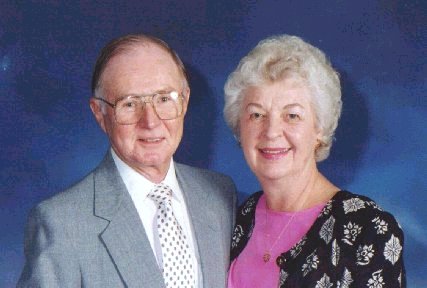|
|
|
Class of 46
Roger and Mona Luther

As with other ZB '46 members, in September 1946, I joined the Army. Several others from our class went together to join but within a few hours we were separated and I was on my way to Fort Sheridan and then to Fort Lewis, Washington, for basic training. Much to my surprise I found that Maurice Ball was in my same training battalion but in company B. I was in company D. Didn't have a chance to see "Mo" very much but did learn that his mother made him a very popular person as she continuously sent him "care" packages Upon completing basic training I shipped out for Japan. I had my 18th birthday on the troopship "General Morton". After landing in Yokohama, Japan, amongst the ships in the harbor, bottom side up and the bombed out docks, we were taken to the 4th Replacement Depot. Next stop was the 64th Engineers Topographical Battalion, Tokyo, Japan, where I was assigned to the Headquarters Company. A short time later I ran into Norman St. Germain, who was also assigned to the 64th but to B Company. While stationed at the 64th we had several mini ZB 46's reunions. On one occasion we had together Maurice Ball, Clyde Congdon, Bob Rickey, Norman St. Germain, Bill Benton (who was on leave from Korea) and myself. Corwin Gustafson was also in Japan but at the southern end of Japan so we did not have an opportunity to get together. Thirteen months later I was again on a troopship, the General Freeman, heading home.
In 1948, Bill Benton, Dan Banks and I were accepted at Purdue University and left for West LaFayette, Ind. Prior to that however, I had met Mona Ballegooyen, ZB '49, and as a result, the route between Purdue and Zion became quite familiar. On March 23, 1951, we were married and Mona became a loyal "Purduvian's". In 1952, I graduated with a BSME degree and we moved back to Zion. I had taken a job with the Anchor Coupling Co., in Libertyville, in the Engineering Department. We manufactured hydraulic couplings, hose assemblies and fittings. It was an interesting time as most construction equipment manufacturers were changing over from cable operated equipment to hydraulics, plus automotive hydraulics was also coming into use. During that time I managed to receive six U.S. patents for our products. As a result of my previous experience in Japan I was closely involved with our Japanese licensee leading to additional involvement and numerous visits to Japan, England, Belgium, Singapore and South Africa. I retired in 1983 as Vice President of Operations. Three days after leaving Anchor I went to work at Laserage Technology, in Waukegan, as Chief Engineer to organize an Engineering Department. Laserage was a laser job shop doing Laser cutting of ceramic for electronic products. We later expanded into metal cutting and welding of products requiring close tolerances and fine finishes. I retired from Laserage in 1993 as Vice President of Operations. Since that time I have been kept busy as a Trustee of Beach Park and as Chairman of the Public Works Department.
Mona and I had two children, Audrey, born in 1954, and Andy born in 1956. They are both married and each have had two children. Ages 20, 17, 12 and 7. They are all avid soccer players and like their grandfather two of them are left handed.
Mona has been an active homemaker, busy in the Christian Catholic Church (now Christ Community Church) as a teacher, in the Nursery and Bell Choir she is also an avid quilter. I have been active in the CCC serving two terms as a Trustee, on two building committees and for the last 56 years as a member of the guard organization.
Other interests include hunting, fishing, our cottage in Door County, WI, photography, wood carving of songbirds and chip carving. We enjoy traveling and one year we had a 46'rs trip to Alaska as we found Dud, Ramona, Jack and Lorraine on the same cruise. Had a great time.
Roger's Photo Gallery
|
|
Carved flying cardinal. |
Carved flying hummingbird. |
|
|
Chip carved plate. |
Chip carved dove plate. |
Chip Carving
Chip carving is a form of wood carving, which I have been
told, started in the Scandinavian countries hundreds of years ago. It is carving using a
short blade knife and carving a pattern out of, usually a flat piece of wood, and
highlighting the pattern by actually cutting chips from the wood. The pattern is
drawn on the wood. After carving the wood is either stained or left natural
depending on the wishes of the carver.
The birds are carved from a block of wood pre cut with a band saw to a rough shape and
then carved to the finished shape. The flower and stem in the humming bird picture are
also carved. For me the tough part of bird carving is the painting to get the colors
right. It drives me nuts hence the chip carving.
These are carvings in our home, plus others, that make excellent dust
collectors.
For me carving is a great relaxer. When I was working I'd come home and generate a
few chips around the house. Probably helped maintain what little sanity I have left.
This Page Revised 15 October 2004